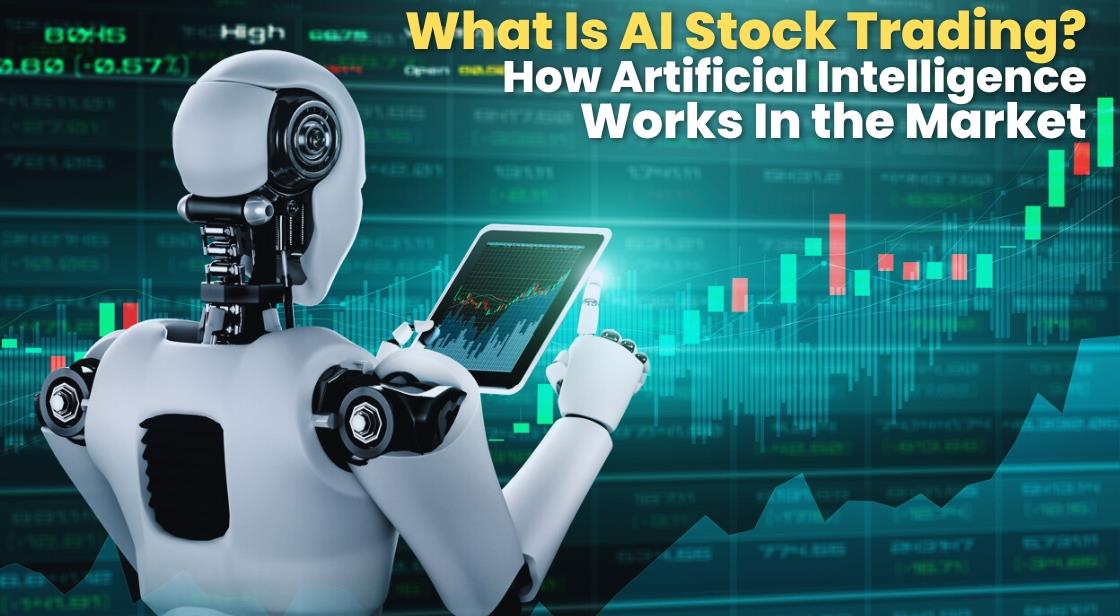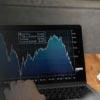What Is AI Stock Trading? How Artificial Intelligence Works in the Market

Blog Post
The global financial landscape is undergoing a transformative shift, driven by the integration of artificial intelligence (AI) in stock trading. AI trading, a broad term encompassing various applications of AI in the stock market, is revolutionizing how investors approach market analysis and decision-making. By harnessing the power of machine learning and predictive analytics,
AI trading algorithms can process vast amounts of historical data, financial news, social media sentiment, and other relevant information to identify trading opportunities and execute trades at optimal times.
According to a report by Allied Market Research, the global AI in the fintech market was valued at $7.91 billion in 2020 and is projected to reach $26.67 billion by 2026, growing at a CAGR of 22.5% from 2021 to 2026. This surge underscores the increasing reliance on AI-driven tools in the financial sector.
The rapid adoption of AI trading is evident as major financial institutions and hedge funds leverage this technology to gain a competitive edge. For instance, BlackRock, the world's largest asset manager, utilizes its AI-powered platform, Aladdin, to analyze vast datasets and uncover hidden patterns, enabling more informed investment decisions.
As AI continues to evolve, its potential to enhance efficiency, reduce errors, and provide 24/7 market monitoring makes it a valuable asset for investors. However, understanding the associated risks, such as overreliance on historical data and lack of transparency, is crucial.
This article delves into the mechanics of AI trading, its benefits, potential risks, and the future of this innovative technology in the financial market.
How AI is Changing Stock Trading: Insights into Artificial Intelligence's Market Impact
Artificial intelligence (AI) is rapidly transforming the way we invest. AI trading, a broad term encompassing various applications of AI in the stock market, is on the rise with a projected market size of USD 11.17 billion by 2027. This technology is revolutionizing investment strategies by offering distinct advantages such as faster analysis of vast datasets, 24/7 market monitoring, and the potential for superior returns.
However, AI trading also comes with inherent risks, including a lack of transparency in algorithmic decision-making and an overreliance on historical data. As AI technology matures and regulations adapt, investors can expect AI to play an increasingly prominent role in the financial landscape. By understanding both the benefits and drawbacks of AI trading, investors can make informed decisions about incorporating this powerful toolkit into their investment strategies.
What is AI Trading?
AI trading refers to the use of artificial intelligence, machine learning, and predictive analytics to automate investment decisions in the stock market. AI algorithms can analyze vast amounts of historical market data, financial news, social media sentiment, and other relevant information to identify trading opportunities and execute trades at optimal times.
The financial world is undergoing a significant transformation as artificial intelligence (AI) disrupts traditional investment strategies. AI trading, a broad term encompassing various applications of AI in the stock market, is rapidly changing how investors analyze markets, make decisions, and potentially achieve better returns.
Demystifying AI Trading:
AI trading leverages the power of machine learning and predictive analytics to automate investment decisions. These algorithms can analyze vast amounts of data – historical stock prices, trading volumes, company financials, economic indicators, news articles, social media sentiment, and even satellite imagery! By processing this data, AI can identify patterns and trends that human investors might miss, potentially leading to more informed trading decisions.
Also Read: Top Highest Valued Currencies in the World
The Mechanics of AI Trading:
Let's delve deeper into how AI trading operates:
Data Powerhouse:
The core of AI trading lies in its ability to ingest and analyze massive datasets. Imagine AI algorithms sifting through years of historical data, identifying subtle correlations between economic indicators and stock price movements, or gauging public sentiment towards specific companies based on social media trends. This comprehensive analysis empowers AI to identify potential opportunities and make informed predictions.
Algorithmic Decision-Making:
Based on the analyzed data, AI algorithms generate trading signals. These signals can be simple buy/sell recommendations or more complex strategies, such as determining the optimal quantity of shares to buy or sell at a specific price point. The complexity of these algorithms can vary, ranging from basic rule-based systems to sophisticated machine learning models that constantly learn and adapt.
High-Frequency Trading (HFT):
A specific type of AI trading is high-frequency trading (HFT). HFT utilizes powerful computers to analyze markets and execute trades at lightning speed, often in milliseconds. This approach aims to capitalize on tiny price discrepancies across different markets. Think of HFT as exploiting fleeting market inefficiencies that human traders simply can't react to fast enough.
Examples of AI Trading in Action:
Here are some real-world examples of how AI trading is being employed:
-
Identifying Early Movers: AI algorithms can analyze news articles and social media sentiment to identify companies gaining traction before the broader market takes notice. This allows investors to potentially get in on the ground floor of promising companies before their stock prices soar.
-
Risk Management: AI can help investors manage risk by analyzing historical data and market trends to predict potential volatility. This allows for the creation of more robust risk management strategies, helping investors navigate market downturns more effectively.
-
Portfolio Optimization: AI-powered portfolio management tools can analyze an investor's risk tolerance and financial goals, and then automatically construct and adjust a diversified portfolio based on real-time market conditions. This allows for a more hands-off approach to investing, potentially freeing up an investor's time while still aiming to achieve their financial objectives.
Remember: While AI trading offers a powerful toolkit, it's crucial to approach it with a clear understanding of its limitations. In the next section, we'll explore the potential risks associated with AI trading.
AI Trading Tools: Empowering Investors
The rise of AI trading has spawned a diverse ecosystem of tools that empower investors of all levels to navigate the complexities of the financial markets. From portfolio management to personalized strategy building, AI is transforming how investors approach their financial goals.
1. AI-Powered Portfolio Managers: Your Personalized Financial Butler
Imagine having a dedicated financial advisor constantly monitoring the market, analyzing your risk tolerance, and automatically adjusting your portfolio to maximize returns. AI-powered portfolio managers offer a glimpse into this future. These intelligent tools utilize advanced algorithms to:
-
Craft a Personalized Portfolio: Tailored to your risk tolerance and financial goals, AI portfolio managers consider your age, income, investment horizon, and risk appetite to build a diversified portfolio across asset classes such as stocks, bonds, and real estate investment trusts (REITs).
-
Constant Market Monitoring: AI algorithms relentlessly analyze market trends, news feeds, and economic indicators, dynamically adjusting your portfolio allocation as circumstances evolve. This ensures your portfolio remains aligned with your goals in a constantly shifting market landscape.
-
Automated Rebalancing: Market fluctuations can disrupt the initial balance of your portfolio. AI portfolio managers automatically rebalance your holdings to maintain your desired asset allocation, ensuring optimal diversification and mitigating risk.
Betterment -
A leading robo-advisor platform leveraging AI to build and manage personalized investment portfolios. Betterment analyzes customer data to create a diversified portfolio based on individual risk tolerance and financial goals.
2. Trading Robots: The Disciplined Executioners
Trading robots, also known as algorithmic trading bots, are software programs equipped with pre-defined trading rules based on technical indicators and market conditions. These robots act as disciplined executors, removing human emotions from the equation and ensuring consistent trade execution when specific criteria are met.
-
Backtesting Strategies: Before deploying a trading robot with real capital, investors can backtest its strategies using historical data. This allows them to evaluate the robot's performance under various market conditions, mitigating potential risks.
-
24/7 Market Monitoring: Unlike human traders, trading robots can operate continuously, monitoring markets around the clock and executing trades based on pre-defined rules, even outside regular trading hours. This can be particularly beneficial for capitalizing on fleeting market opportunities.
-
Reduced Emotional Trading: Human emotions can cloud judgment and lead to irrational decisions. Trading robots operate based on predefined rules, eliminating emotional biases and ensuring a more disciplined trading approach.
Example:
TradeSanta -
A cloud-based platform offering a user-friendly interface for creating and deploying trading bots. TradeSanta allows investors to design custom strategies based on various technical indicators and automate their trade execution.
3. AI Signals: Beacons of Opportunity
AI-generated signals act as early warnings, notifying investors of potential trading opportunities. These signals are generated by algorithms that analyze market data, technical indicators, and social media sentiment to identify stocks that meet specific criteria.
-
Customizable Filters: Investors can set up personalized filters for AI signals, specifying desired criteria such as stock price range, trading volume, or specific technical indicators. This ensures they receive only relevant signals that align with their investment goals.
-
Actionable Insights: AI signals go beyond simply identifying potential opportunities. They often provide additional insights, such as suggested entry and exit points, risk assessments, and even potential price targets. This information empowers investors to make informed trading decisions.
-
Reduced Research Time: Manually researching potential investments can be time-consuming. AI signals streamline this process by filtering through vast amounts of data and identifying stocks that meet an investor's predetermined criteria. This frees up valuable time for further analysis and strategy development.
Example:
TrendSpider -
A trading platform that utilizes AI to identify trends and patterns in the market. TrendSpider provides real-time market analysis and generates AI-powered trading signals, empowering investors to make informed decisions.
4. Strategy Builders: Craft Your Investment Arsenal
Strategy builders are AI-powered tools that allow investors to create and test their own customized trading strategies with the assistance of artificial intelligence.
-
User-Friendly Interface: Many strategy builders offer user-friendly interfaces that don't require extensive coding knowledge. Investors can visually define their strategies by selecting technical indicators and setting entry/exit points with drag-and-drop functionality.
-
Backtesting Capabilities: The true power of strategy builders lies in their backtesting capabilities. Investors can test their strategies using historical data to assess their potential performance under various market conditions. This allows for refining and optimizing strategies before deploying them with real capital.
-
AI-Powered Optimization: Some advanced strategy builders leverage AI to suggest improvements to user-defined strategies. For instance, AI can recommend adjustments to entry/exit points or suggest combining different indicators for potentially better performance.
Example:
Zipline -
An open-source Python library specifically designed for backtesting algorithmic trading strategies. Zipline allows investors to create custom trading algorithms using Python code and then test them on historical market data. This enables investors to refine their strategies before risking real capital in the market.
Unveiling the Benefits of AI Trading
AI trading offers a compelling arsenal of advantages for investors, transforming how they approach the market and potentially boosting their returns. Here's a deeper dive into the key benefits:
1. Unleashing Efficiency: Time Saved, Decisions Empowered
Reduced Research Time and Improved Accuracy:
AI automates the heavy lifting of data analysis and research, freeing up valuable time for investors to focus on core aspects of their financial strategy. Instead of poring over endless financial reports and news articles, investors can utilize AI to analyze vast datasets in seconds, extracting key insights with greater accuracy compared to traditional methods. This efficiency allows investors to make more informed decisions and potentially capitalize on fleeting market opportunities.
Example:
BlackRock Aladdin -
A powerful AI platform used by BlackRock, the world's largest asset manager. Aladdin utilizes machine learning to analyze vast amounts of data, uncovering hidden patterns and generating insights that human analysts might miss. This allows BlackRock to make more informed investment decisions and potentially outperform the market.
2. Pattern Prediction: Unveiling the Hidden Language of Markets
AI-Powered Trend Identification:
One of the hallmarks of AI trading is its ability to identify complex patterns and trends in the market that human investors might overlook. AI algorithms can analyze vast amounts of data, including historical prices, trading volumes, social media sentiment, and even satellite imagery, to uncover subtle correlations and predict future market movements. This predictive power can provide AI-powered investors with a significant edge in the market.
Example:
Kensho -
An AI-powered financial analytics platform used by hedge funds and investment firms. Kensho utilizes natural language processing to analyze vast amounts of financial data, news articles, and social media posts. This allows investors to identify emerging trends and make informed investment decisions based on a more comprehensive understanding of the market landscape.
3. Risk Management Reimagined: Proactive Protection for Your Portfolio
Enhanced Risk Assessment:
AI tools excel at analyzing historical data and market trends to assess potential risks associated with specific investments. This allows investors to develop more robust risk management strategies. AI can identify potential market downturns, industry disruptions, or company-specific risks, enabling investors to adjust their portfolios accordingly and mitigate potential losses.
Example:
AQR Capital Management -
A hedge fund known for its innovative use of quantitative models and AI in risk management. AQR utilizes AI to analyze vast sets of financial data and identify potential risks across different asset classes. This allows AQR to construct diversified portfolios that are less susceptible to market volatility.
4. Cost Optimization: Streamlining Operations, Boosting Returns
Lower Overhead Costs:
AI trading can potentially reduce investment costs in the long run. Traditional investment firms require large teams of researchers, analysts, and traders, leading to significant overhead expenses. AI can automate many of these tasks, such as data analysis, trade execution, and portfolio rebalancing. This translates to lower operational costs for investors, potentially boosting their overall returns.
Example:
Wealthfront -
A leading robo-advisor platform that leverages AI to manage investment portfolios for individuals. Wealthfront utilizes AI to automate portfolio construction, investment research, and trade execution. This allows Wealthfront to offer low-cost investment management services to a wider range of investors.
5. 24/7 Market Vigilance: Seizing Opportunities Around the Clock
Unrelenting Market Monitoring:
Unlike human investors who are limited by work hours and sleep, AI algorithms can operate continuously, monitoring the market 24/7. This allows them to identify and capitalize on trading opportunities that might arise outside of regular trading hours. For instance, AI can react to breaking news events or sudden market shifts in real-time, executing trades to potentially maximize returns.
Example:
Alpaca -
A commission-free brokerage platform that allows investors to build and deploy algorithmic trading strategies. Alpaca provides access to real-time market data and execution tools, enabling investors to create AI-powered trading algorithms that can capitalize on market opportunities around the clock.
By leveraging these benefits, AI trading is transforming the investment landscape, empowering investors with a powerful toolkit to navigate the complexities of the market and potentially achieve their financial goals. However, it's crucial to understand that AI trading also comes with certain risks. In the next section, we'll explore the potential downsides of AI trading and how investors can approach this technology with caution.
Understanding the Risks of AI Trading
While AI trading offers significant benefits, it's crucial to be aware of the associated risks:
-
Black Box Problem: The complex nature of AI algorithms can make it difficult for investors to understand how they arrive at trading decisions. This lack of transparency can be concerning and raise ethical questions about the use of AI in the financial sector.
-
Over Reliance on Historical Data:: AI trading algorithms are trained on historical data, which can be a double-edged sword. While historical data provides valuable insights, the stock market is inherently volatile and can be impacted by unforeseen events. These events, such as natural disasters, political upheavals, or technological breakthroughs, can disrupt historical patterns and render AI predictions inaccurate. Investors who rely solely on AI and neglect other factors might miss crucial information and make poor investment choices.
-
Larger-Scale Errors: As the speed and complexity of AI trading increase, the potential for large-scale errors grows. A single line of faulty code within an AI algorithm can have significant consequences when multiplied across thousands of trades executed in milliseconds. Investors who utilize AI trading platforms need to ensure the robustness and security of the underlying algorithms to minimize the risk of such errors.
-
Cybersecurity Concerns: AI trading systems are potential targets for cyberattacks. Malicious actors could exploit vulnerabilities to gain control of algorithms, manipulate markets, or steal sensitive financial data. Investors and companies employing AI trading technology must prioritize robust cybersecurity measures to protect their investments and maintain market integrity.
-
Regulation Challenges: The rapid development of AI trading poses challenges for regulatory bodies. Existing regulations might not adequately address the unique characteristics of AI-driven investment strategies. Regulators need to adapt and implement frameworks that ensure fair, transparent, and accountable practices within AI trading.
The Future of AI Trading: A Collaborative Approach
AI trading is undoubtedly transforming the financial landscape. As the technology matures and regulatory frameworks evolve, we can expect AI to play an even more significant role in investment strategies. However, it's crucial to remember that AI is a tool, not a replacement for human judgment. The most successful investment strategies will likely involve a collaborative approach, combining the analytical power of AI with the experience and intuition of human investors.
Conclusion:
AI trading offers a powerful toolkit for investors, enabling faster analysis, 24/7 market monitoring, and potentially improved returns. However, investors must be aware of the risks associated with AI, such as overreliance on historical data and lack of transparency. By understanding both the benefits and drawbacks of AI trading, investors can make informed decisions about incorporating this technology into their investment strategies. As the technology continues to evolve, a collaborative approach that leverages the strengths of both AI and human expertise will likely be the key to success in the ever-changing world of finance.
Disclaimer: The information provided in this blog post is for educational and informational purposes only and should not be construed as financial or investment advice. The content is based on current market trends and research, but the stock market is inherently volatile and subject to change. Investors should conduct their own research and consult with a qualified financial advisor before making any investment decisions. The use of AI trading tools and strategies involves risks, including the potential for significant financial loss. The author and publisher of this blog are not responsible for any actions taken based on the information provided herein.
You May Like
EDITOR’S CHOICE












